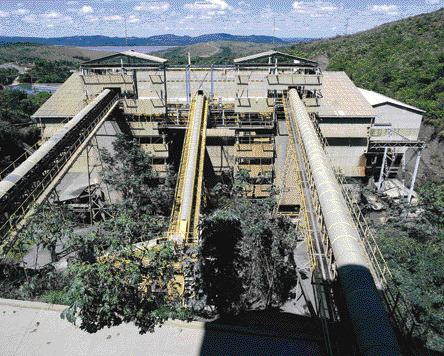Finding and developing new reserves to replace mined ounces is a constant struggle for gold producers, especially in today’s heated gold market where the competition for projects is fierce and permitting is becoming increasingly challenging.
The ideal scenario, then, is to find more ounces around an existing mine where the permits, infrastructure and operating team is already in place. This approach to growth has paid off in spades for Kinross Gold (K-T, KGC-N), which is about to triple its production at the 20-year-old Paracatu mine in southeastern Brazil as part of a massive expansion plan.
The expansion will boost annual production at Paracatu to 557,000 oz. from 175,000 oz. for the first five years, making the open-pit mine by far the biggest operation in Kinross’s portfolio (next is Round Mountain in Nevada at 335,000 oz. per year). The economies of scale will allow the cost of sales at the mine to drop to US$230 per oz. from US$332 per oz. in 2006.
The town of Paracatu, 3 km south of the mine, is in favour of the project, says Tracey Thom, director of investor relations and corporate communications for Kinross. Rio Paracatu Mineracao (RPM), Kinross’s operating arm in Brazil, is the largest employer in the otherwise agricultural town.
“We’ve had overwhelming support from the community,” Thom says. “The expansion will create a lot of new jobs and we’ve done a lot of work to help the community build housing and help out the less fortunate in the area.”
Kinross owns Paracatu outright after buying the 51% interest it did not already own from Rio Tinto (RTP-N, RIO-L) at the end of 2004. Although Rio Tinto did drill beneath the oxide zone (the current source of production) and always bottomed in gold-rich sulphides, investing in the technology to process the sulphide resource was not on the mining giant’s priority list.
But there was no escaping the fact that the ore was getting harder as the pit deepened, resulting in an accelerating drop in throughput. Under the supervision of a team of experts in the field of semi-autogenous grinding (SAG) mill design and operation, RPM launched a pilot study using a SAG mill leased from another Brazilian operator.
The results of that test work, coupled with an aggressive exploration campaign by Kinross, led to the expansion decision.
“Paracatu wasn’t a core operation for Rio Tinto, but for a company like Kinross it’s a huge mine,” Thom says. “When we bought the other fifty-one per cent, the first thing we did was to get four drills on the ground. (Former president and CEO) Bob Buchan insisted that we get out there and drill the daylights out of it and, sure enough, there was a significant untapped orebody there.”
During 2005, Kinross drilled 267 holes, or 48,660 metres, at Paracatu. The drilling demonstrated that anomalous gold grades (greater than 0.2 gram per tonne) occur within a 120- to 150-metre tabular zone that has been traced for 6 km and has a width of about 3 km. The zone remains open along strike and downdip.
Paracatu is a unique deposit consisting of finely disseminated gold mineralization within a bedded sedimentary host (phyllites of the Morro do Ouro sequence) that has been metamorphosed to lower greenschist facies.
The deposit is extraordinary in its lateral continuity and the consistency of its grade distribution and recovery characteristics. Sulphides associated with the gold are mostly arsenopyrite and pyrite with some pyrrhotite and lesser amounts of chalcopyrite, sphalerite and galena.
As of the end of 2006, following Kinross’s drilling campaign, reserves stood at 1.26 billion tonnes grading 0.4 gram gold per tonne, or 16.4 million oz. Measured and indicated resources were 67.5 million tonnes grading 0.33 gram gold per tonne, or 722,000 oz.
As a result of the US$470-million expansion, Kinross will be able to exploit this huge new reserve by tweaking the mining method and installing a new mill that can process harder sulphide ore.
The existing mill has been processing oxide and heavily weathered ore since 1987, with successive upgrades boosting throughput to a peak of 20 million tonnes per year in 1999. Annual throughput has since fallen to 17-18 million tonnes and recoveries to about 77% because of increasingly harder ore.
“Paracatu has been like mining a beach, with little blasting and grinding required,” Thom says. “The harder ore requires some blasting and a SAG mill to treat it.”
By installing a new 41-million-tonne-per-year treatment plant to process the harder ore that will be encountered as the mine goes deeper, Kinross can triple annual throughput to 61 million tonnes. The existing mill will continue to process softer near-surface ore at a rate of about 20 million tonnes per year.
Kinross has completed about a quarter of the work that needs to be done in preparation for startup in 2008 and is so far on time and on budget. The earthworks — a challenge because of a particularly wet rainy season — are now complete and the building foundations are being prepared for the new mills. RPM recently received permission to tap into the national grid and is seeking approval to build a 230-kilovolt power line.
The current life of mine production for Paracatu is expected to be roughly 418,000 oz. per year at an average cost of sales of about US$307 per oz., with higher production (557,000 oz.) at lower costs (US$230 per oz.) in the first five years.
As a result, Brazil will become a cornerstone of Kinross’s near-term growth, providing about a third of the company’s production of 1.8-1.9 million oz. in 2009, if ounces from the 50%-owned Crixas mine to the northwest are included.
— The author is a freelance writer specializing in mining issues, and principal of Toronto-based GeoPen Communications (www.geopen.com).


Be the first to comment on "Brazil becomes cornerstone for Kinross"